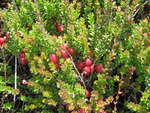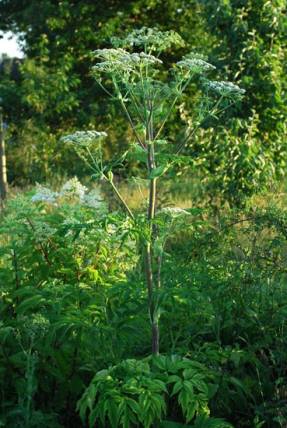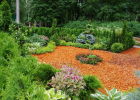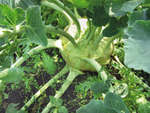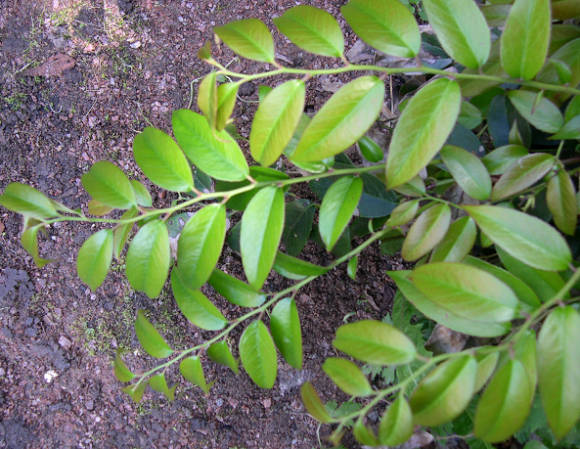 |
Yarrow (Achilleamillefollium) — perennial herb of the Aster family, 20-80 cm high, with a thin creeping rhizome, from which shoots with rosettes of basal leaves and flowering unbranched stems extend. The leaves are alternate, lanceolate, twice or three times (not to the very base) pinnately dissected. Inflorescences are small, numerous baskets, collected at the top of the stems in complex shields. There are 5 ligulate flowers, they are white, rarely pink, 14-20 staminate bisexual flowers. Achenes are flat, oblong, silvery gray. It blooms from June to October, the seeds ripen in July-September.
This plant is found almost throughout Russia, with the exception of the northern regions of Siberia and the Far East, desert and semi-desert regions of the Lower Volga region. Often grows on the outskirts of fields, along roads, in forest belts and as a weed in kitchen gardens, orchards and fields; sometimes forms continuous thickets on deposits. Quite a large part of medicinal raw materials is harvested in nature.
 |
Along with the raw material of yarrow, in medicine, raw materials of other species close to it are also used.
Asian yarrow (AchilleaasiaticaSerg.) Is distributed in the Far East, in all steppe and forest-steppe regions of Siberia (up to Kuznetsk Alatau inclusive) and in Tarbagatai. It differs in that the leaf blades are dissected almost to the central vein, the ligulate flowers are pink in color, and the inflorescences are loose.
 |
Yarrow bristly (Achilleasetacea Waldst. et Kit.) has leaves of the same structure as that of Asiatic yarrow, but more densely pubescent and grayish underneath. Reed flowers are yellowish-whitish, baskets are collected in dense, dense, convex scutes. It is distributed mainly in the south of the European part in the zone of mixed and deciduous forests, forest-steppe and steppe zones; almost everywhere in the Caucasus, except for Talysh and Eastern Transcaucasia.
And finally yarrow pannonian (Achillea pannonica Scheele) is close to the previous species, but differs in wider lobes of leaf segments, larger wrappers of baskets and tongues of marginal flowers. Occurs in forest-steppe and steppe regions in the south-west and south of the European part of the country.
Raw materials are not allowed to be used in medicine yarrow (Achilleanobilis L.), which differs from the main species by dense gray tomentose leaf pubescence.
In recent years, yarrow is grown in culture. This is due to the fact that plants have an unstable chemical composition, and cultivation in culture allows obtaining raw materials of the desired quality. In European countries, varieties are represented mainly by tetraploids. In our country, the Vasyurinsky variety was bred.
Cultivation and reproduction
Yarrow is undemanding to soils, loves open, sunny places. Propagated by seeds and rhizome segments. When preparing the soil for digging, add 30-40 g of superphosphate and 10-15 g of ammonium nitrate per 1 m2. Seeds are sown in early spring to a depth of 0.5-1.0 cm. The distance between rows is 45-60 cm. If the seedlings are very dense, when 3-4 pairs of leaves appear, the seedlings are planted at a distance of 10-15 cm or thinned out. In favorable years, with early spring sowing, the plants bloom in the fall of the same year, and in the second year of life they already bloom profusely. With summer or winter sowing, the plants bloom only the next year.
With vegetative propagation, segments of rhizomes in early spring or autumn are planted at a distance of 20-25 cm from one another to a depth of 10-12 cm, with row spacing of 40-50 cm.At the beginning of active growth, it is advisable to feed the plant with ammonium nitrate, complex mineral fertilizer or mullein infusion. The same is done annually in early spring at the beginning of regrowth. As necessary, the plantings are weeded and loosened.It is better to keep the plant in one place for no more than 3-4 years.
Preparation of medicinal raw materials
Grass and flowers are used as medicinal raw materials. The grass is harvested during the flowering period of the plant, cutting off the tops of the stems up to 15 cm long with sickles, knives or pruning shears without coarse, leafless bases or separately inflorescences. You should not try to pluck the yarrow with your hands, the plants are torn out by the roots and the underground parts of the rhizomes and roots are damaged, they begin to wither and feel depressed. Raw materials are collected in dry weather, after the dew has dried. Dried yarrow in the shade in the air, in a well-ventilated area, spreading it in a layer of 5-7 cm on paper or cloth and stirring occasionally. In good weather, it dries up in 7-10 days. It can also be dried in dryers at a temperature of + 40 ° C. The end of drying is determined by the fragility of the stems.
Chemical composition and properties
Yarrow leaves contain vitamin K, methyl betaine (0.05%), essential oil (about 0.8%), formic, acetic and isovaleric acids, esters and alcohols; sesquiterpene lactones were isolated from the inflorescences. Essential oil is usually bright green in color. The most valuable component of essential oil is chamazulene (6-25%). In addition, the oil contains cineole, bornyl acetate, camphor, linalyl acetate, etc. Due to the fact that this plant has a very extensive range and grows in very different weather and soil conditions, quite a few chemotypes (or, as they sometimes say, chemorass) have formed. What does this mean from a practical point of view? The plant contains, firstly, a different amount of essential oil and, secondly, it differs in composition, and, accordingly, in its pharmacological and antimicrobial action. The same goes for the flavonoid content. For example, when one of the studies compared essential oils from Italy and Portugal, it turned out that Italian oil contains predominantly alpha-asarone (25.6-33.3%), beta-bisabolic (27.3-16.6%) and alpha-pinene (10.0-17.0%), while the main components of the sample from Portugal are trans-thujone (31.4-29.0%), trans-chrysanthenyl acetate (19.8-15.8% ) and beta-pinene (1.2-11.1%). High rates of antifungal activity of the oil were found against the causative agent of thrush Candida albicans, pathogens of mycoses Trichophyton rubrum, T. mentagrophytes, T. mentagrophytes var. interdigitale, Microsporum canis, Aspergillus niger, etc. The main properties that determine the internal use of yarrow: anti-inflammatory, carminative, antispasmodic, wound healing, blood-purifying, as well as external - antiseptic, tonic. Increases blood clotting. Yarrow has been familiar to people since ancient times. Another hero of the Trojan War, Achilles, treated wounded soldiers with him. In Russia, among the people, it is known as woodworm, cut grass, bloodstain, because it was used mainly to stop blood from cuts. Bleeding wounds were moistened with juice from the leaves of yarrow or sprinkled with dry crushed grass. He was glorified by the Russian chronicles, telling about the healing of the grandson of Dmitry Donskoy, who suffered from nosebleeds. In folk medicine, it was used for pain, malaria, insomnia, urolithiasis, liver diseases, urinary incontinence, as a wound healing and hemostatic during heavy menstruation. Later, yarrow in folk medicine began to be taken for dysentery, uterine and hemorrhoidal bleeding, to improve appetite and digestion, with gastritis, gastric ulcer and duodenal ulcer, colitis and enterocolitis. Often prescribed together with nettle leaf extract. Yarrow is a part of the complex drug "LIV 52", produced in India and approved for use in the treatment of liver diseases, infectious, toxic hepatitis, as well as chronic hepatitis. Freshly squeezed juice is used for pulmonary tuberculosis and anemia. Infusion of yarrow cook by pouring 1 tablespoon of dry herbs with 1 cup of boiling water. Insist for 20-30 minutes, filter and drink in 3 divided doses during the day. If as a gastric remedy, then be sure to eat. Tea made from a mixture of yarrow and chamomile flowers (1 tablespoon per glass of boiling water) soothes severe stomach pains. In this case, a heating pad is placed on the stomach area. Tea from flowers of yarrow drink 3 glasses a day with uterine bleeding and hemoptysis. Leaf juice with honey (3 teaspoons a day) improves appetite and metabolism, helps with liver and female diseases. Crushed yarrow leaves are applied to the burned areas of the skin, but it helps in this case better. ointment... It is prepared as follows: 40-50 g of crushed flowers and leaves are poured with 1 glass of melted unsalted lard, insisted in a water bath or in an oven for 8-10 hours, filtered through cheesecloth and cooled. In case of cuts and abrasions, juice from fresh grass, yarrow is poured into the wound, or crushed grass is applied to it and fixed with a bandage. According to the ancient herbalists, then decoction of flowersyarrow and chamomile wash well: the skin becomes velvety, matte. And in recent years in Europe it is very fashionable to use wild plants for food. Yarrow is recommended finely chopped in a salad, on a butter sandwich and goes well with hard-boiled eggs, cottage cheese and used in herbal sauces. In Sweden, in ancient times, it was even used for brewing beer. Contraindications Internal use of yarrow is contraindicated in pregnancy. In ornamental gardening, several types of yarrow are used, but this does not exclude the inclusion of the simplest yarrow in landscape compositions. In culture, the bushes are large and elegant with very large inflorescences. Plants can be placed on the site in a group or in a mixborder. Plants with pink flowers look especially impressive. And also a plantpossesses insecticidal properties, so some gardeners and gardeners use it to destroy harmful insects: aphids, spider mites, thrips. To prepare the infusion, the dried and crushed grass is poured with boiling water, infused for an hour, then filtered and dissolved in an infusion of laundry soap (a bucket of infusion requires about 1 kg of grass and 20 g of soap).


Yarrow recipes
Yarrow on a backyard


